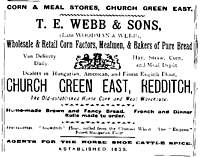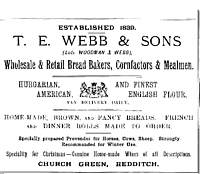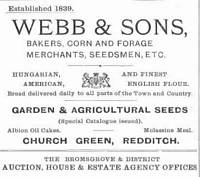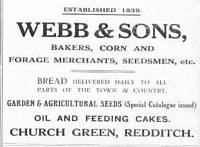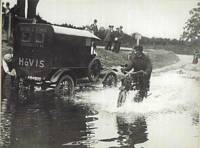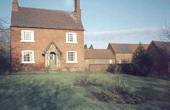|
|
The start of the new century was marked by the passing of the monarch who had defined the previous one - Queen Victoria died in January 1901, and no-one under the age of 70 could remember life under another monarch. The Victorian Age had been one of the most significant in the nation's history, as Britain became a world power both politically and commercially, but times were already changing and the stability of life in Europe would soon be a fond memory. The census was taken on Sunday 31st March, and is particularly important to genealogists as being, at the time of writing, the latest census available. It shows stable Victorian families full of optimism for the future - the era of the motor car, the wireless, the telephone, the gramaphone and the photograph was about to make significant changes to the lives of ordinary working people.
Webbs , in its prominent position in Church Green, was now a key business in the town of Redditch, catering for both town and country customers. It had prospered under the patronage of Thomas Edward, after the tragic death of his brother William in 1887.
A the age of 49 his wife Catharine
kept an eagle eye over the household and still had young children
to look after. Her father John Cheer, latterly living at Mappleborough
Green, died on February 3rd 1901, marking another change in the
established family pattern.
He would remain a bachelor until the age of 40, and was well known in Redditch society being a keen member of the Conservative Club and an enthusiastic mason.
Second daughter Gertie (15) was not at home in 1901. She was in Leamington with her widowed Aunts Hickley and Cranmore. (Ref 2) gives details of Gertie. Son Victor was only 13 at the time of the census, but had no plans to settle into the family business in Redditch - he set his sights much further afield. (Ref 3) details the naval career of Victor. Wilfred and Nora were the youngest children, and in the family photo below, taken perhaps in 1898, we see Thomas and Catharine with Aunt Hickley and Aunt Cranmore (Thomas' sisters) at the back of 20 Church Green East. The photographer was probably Ted, who was to pass his interest in photography on to his son John. Note that the aunts are dressed in widow's black, while the diminutive Catharine wears a light coloured dress with leg-o-mutton sleeves. She was always carefully dressed; even in her 90s she insisted on being taken to the dressmaker to have her clothes made in the styles to which she was accustomed, rather than buy modern clothes "off the peg". In the second photo, taken on the promenade at Weston-super-Mare in the 1920s, she is still in a full length dress (but in black, as Thomas had died in 1917). In the later holiday photo (mid 1920s) she is still very formally dressed!
Lillie & her sons with Catharine
Thomas and Catharine might be considered very fortunate to have such a large family survive to adulthood, though they had buried three children in infancy, but it was no doubt irksome for Thomas to have small children still running about when he was managing a business at an age when other men might be considering retirement. So now to consider how the business
had expanded in the years since Thomas had returned to his home
town following the tragic death of his brother William. Thomas
had made good use of the mills, and supplied a wide range of
grain-based products, thus developing the business considerably
from the bakery which his father and brother had owned in Evesham
Street.
Local families would queue up for the first hot loaves of the day, but there were also daily deliveries by van and horse and cart to other parts of the town and outlying villages. Although there were quite a few other bakeries in and around Redditch at this time, most would buy in their flour, and even some of their products from Webbs. The bread ovens were also in demand at Christmas time for roasting turkeys and geese which were too large for the usual domestic ovens. For the farmer and smallholder, Webbs stocked other corn products including "provender for horses, cows and sheep" and "oil cakes". Throughout the 1890s Webbs adverts mention daily deliveries of horse corn, meal and hay, as well as garden and agricultural seeds. Thomas and his sons would be personally acquainted with all the local farmers who would come in to discuss their order. This was a town where all the established Redditch families knew each other, and depended on each other for their trades. By 1906 the adverts describe Webbs as "bakers, corn merchants and seedsmen" , while in 1907 also as "forage merchants". This does not show a change of stock, but rather to remind customers of the comprehensive service. It is interesting to note the changes in vocabulary, as in the early 1890s, they were described as "corn factors" and "mealmen". The business continued to expand, providing a valued service for the town and surrounding villages, but in 1914 came the war which would radically change everyone's lives and marks the real beginning of the twentieth century. In Redditch, as in most towns, young men willingly responded to the call to arms. It was portrayed as an adventure, a chance to break away from the humdrum of normal life and do something exciting. They had no idea of the horrors which awaited them in France and Belgium, and no-one could have predicted the catastrophic loss of life. See Alan Foxall's book "Redditch at War" . Ted joined the Worcester Volunteers, but did not serve abroad, probably as the business couldn't be left. Although approaching 40 at the start of hostilities, he had to declare his availablity for military service, as shown by the Attestation document which he signed in December 1915. In 1915 the horses which had pulled Webbs delivery carts, and moved the grain to the flour mills at Peakman Street were taken to pull artillery at the Front. In later life Catharine was to recount how the women of the immediate area had come out into the street to watch the horses leave, crying to think of the terrible fate which awaited them.
During the years 1914 and 15, Clara sent postcards from Welford-on-Avon to her brother Bertie at the Gresham Works, relating the success of a recruitment drive for the war effort : "I think seven joined. The first to go up was Bennet our mushroom man". Young Wilfred became an ambulance man, but was wounded in the head and had to have a metal plate inserted. To amuse his nephews and nieces later in life, he would tap the plate. He became the master baker at the bakehouse in Church Green. On the death of his father in 1917,
Ernest Edward ("Ted") took over management of
the firm. He had eventually married the previous year at the
age of 40. Elizabeth (Lillie) was the step-daughter of
Herbert Watts, who had moved to join a farming enterprise
at Lodge Farm with his friends the Buckleys. (Ref
4) gives details of the Buckleys, and of Herbert Watts. After
the death of her step-father, Lillie stayed with the Buckleys,
who moved out of Lodge Farm in about 1915. Chris Buckley and
his wife Mignon moved to "Springhill House",
Webheath and Lillie was married from there in 1916, but Frank
seems to have moved away from the area.
Having had a strict Catholic upbringing, Lillie had John baptised at the Catholic Church in Redditch, Mount Carmel (Ref 5) gives further information about the family's attitde to religion. Grandmother Catharine (now known as "Old Gran") had a great deal of influence over the family. She presided over the aunts and uncles while they still lived at 20 Church Green East, above the shop, and she had plenty to say about the upbringing of her grandchildren. Only two of her large family produced any children - Ted who had the three boys, and Nora (who married William Adams, later of the Hangar Motor Company in Birmingham) who had five children. Ted's boys were left in no doubt about the importance of The Shop in their lives, and from the age of eight were expected to help, starting with the packing of seed potatoes. Chapter 11 details their teenage years, and how their lives were affected by the Second World War. |
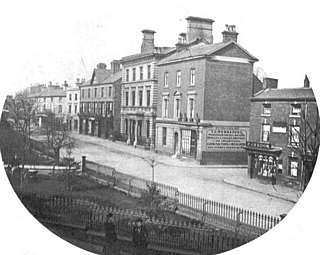
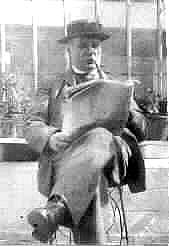 Thomas
Edward, who declared he was aged 58 on the census form, but
was actually 64, described himself as "corn merchant
and employer" and presided over a wide ranging and thriving
business, supplying the wholesale and retail trade.
Thomas
Edward, who declared he was aged 58 on the census form, but
was actually 64, described himself as "corn merchant
and employer" and presided over a wide ranging and thriving
business, supplying the wholesale and retail trade.
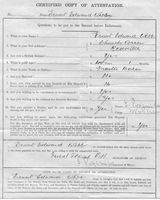
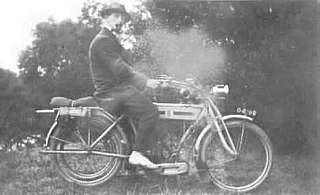
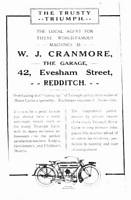
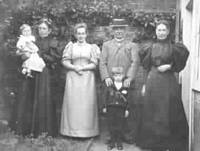
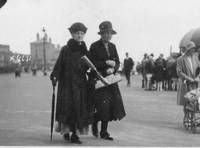
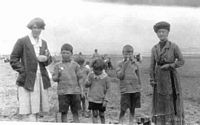
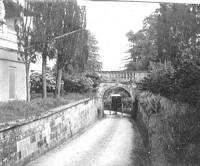 The Peakman Street
mills provided Hungarian, English and American flour, as
many families still baked much of their own bread, cakes and
puddings. However as many Redditch women were employed, either
as outworkers or in the factories themselves, shop-bought bread
was very much in demand. The bakery itself offered a wide range
of fancy bread and rolls, and would take orders for special occasions.
School treats were supplied on special terms, according to an
advert of 1895. One of their most important customers was Hewell
Grange, and the photo shows Webbs horse-drawn van
on its way through the Hewell estate.
The Peakman Street
mills provided Hungarian, English and American flour, as
many families still baked much of their own bread, cakes and
puddings. However as many Redditch women were employed, either
as outworkers or in the factories themselves, shop-bought bread
was very much in demand. The bakery itself offered a wide range
of fancy bread and rolls, and would take orders for special occasions.
School treats were supplied on special terms, according to an
advert of 1895. One of their most important customers was Hewell
Grange, and the photo shows Webbs horse-drawn van
on its way through the Hewell estate.